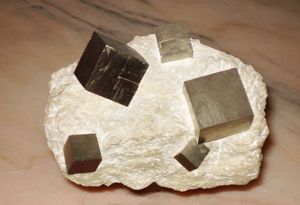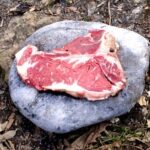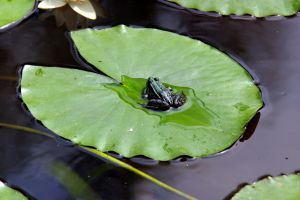Dice used to advance a player’s piece in a board game are little cubes with dots drawn on each of six sides. The distinctive shape often well fits a form of stone, once pure pyrite, that weathers on its outside into a new, brownish mineral called goethite. Shatter one of the stones, and inside the golden hue peculiar to pyrite brightly shines through. In some instances, the outer surfaces appear more of a gunmetal gray, as in this image.
Initially Pyrite
Pyrite frequently occurs as cubic crystal and can be quite beautiful, as in the images of massive pyrite found on the Gem Resources International website, or as perfect cubes in a matrix, seen on the Lapis Mineral Magazine website. These crystals consist of iron persulfide, FeS2. Pyrite bears an appearance similar to gold, hence it has the nickname “fool’s gold.” Iron persulfide, however, is subject to chemical change, which occurs in the presence of air and moisture-both commonly available near earth’s surface.
Then Pyrite Undergoes Chemical Change
The chemical change associated with the conversion of pyrite to goethite is,
4 FeS2 + 15 O2 + (10 + n) H2O –> 4 FeO(OH) • n H2O + 8 H2SO4
Sometimes specimens are said to have had their surface weathered into limonite. This is found in the literature on occasion, but apparently most material identified as limonite actually consists of goethite.
Size and Shape
Size and shape of devil’s dice varies, but typical specimens are cubic and may run from 3/16 inch to 3/4 of an inch in size. The author once viewed a collection with a much larger and non-cubic specimen at the University of Virginia, and had, in fact, found one yet larger than that specimen-it being approximately 4 inches by 1-1/2 inches by 1-1/2 inches in size.1 Unfortunately, it no longer exists, or it would have been donated to a museum collection.
Where Found
Devil’s dice are found throughout the world, including in many U.S. states. Devil’s dice is often discovered resting atop the surface of the ground or partially buried. It is easily identified by its shape and its generally dark brown color. Where one piece is found many pieces can usually be found by even the most casual observer. Larger pieces, because of their shape and weight may be mistaken as ingots of metal. Such pieces should not be damaged in expectation that real gold is within. The author learned this in a most unfortunate way. Having been told the area in which he searched was an old Indian grave mound, he thought he’s uncovered something precious, and so destroyed the piece he had discovered, to his lasting chagrin.
1 The sample was found just outside the southeastern portion of the city of Charlottesville, Virginia, on private land.
References and Resources:
“Regolith geology and geomorphology”, by Graham Taylor and RA Eggleton, page 206.
International Union of Crystallography – “Limonite is Goethite, ” by WT Holser, “Acta Crystallographica,” Volume 6 Part 6 (June 1953).
Personal Experience




